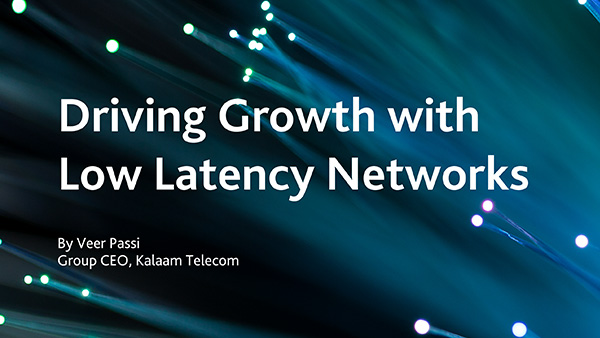In todays interconnected world, the accelerating digital environment and real-time communication is becoming an essential requirement of everyday life. The Middle east region is readily embracing more and more technologies and increasingly recognising the pivotal role that low latency networks play in driving growth and enhancing user experience. Consumers now expect carriers to deliver low latency routes, even when using the most demanding applications and services. It is not enough to simply provide a connection.
According to Future Market Insights, the digital transformation market in the Middle East and North Africa (MENA) is expected to reach a massive $298.2 billion in 2032. The challenge is to provide uninterrupted connectivity while maintaining a consistent global experience.
Low latency networks are primarily characterised by maintaining a minimum delay in data transmission which is a key essential for applications that require real-time interaction and high bandwidth capabilities. Some of them include cloud computing, gaming, financial trading etc. In the context of the Middle East, where sectors like finance, logistics, and e-commerce are experiencing rapid growth, low latency networks can catalyse innovation, enhance productivity, and unlock new opportunities for businesses to compete on a global scale.
Users increasingly depend on low latency for anything from video conferencing to online gaming, so it’s crucial that carriers provide fast communication speeds to remain competitive in 2024. Carriers that prioritise low latency networks with the right partner will drive profitability and capture local and global growth.
A Streamlined Route to Connectivity
One of the key drivers of low latency network development in the Middle East is the region’s strategic position as a gateway between East and West. With its central location and proximity to major global markets, the Middle East serves as a critical hub large enterprise. By investing in low latency network infrastructure, countries in the region can strengthen their connectivity links with key trading partners in Europe, Asia, and Africa, enabling faster and more efficient exchange of goods, services, and information.
One of the biggest causes of high latency is distance. As digitalisation spreads, consumers need to communicate with servers either locally or internationally. The round trip delay (RTD) data takes to reach a client after they make a request can be significantly increased depending on how far the data travels. This time must be as short as possible, however, delays can be caused as travelling data needs to cross multiple networks. The more networks the data needs to pass through, the higher the chance for a delay to occur. This means the physical paths between point A and B should be as direct as possible or should follow a linear path. The right partner can provide customers with end-to-end low latency routes.
A network optimised for ultra-low latency can process a very high volume of data with minimal delays. They are specifically designed to provide organisations with real-time access and response to their data while streamlining communications. With a low latency solution, carriers can operate bandwidth-hungry applications with improved efficiency and reduced latency.
Navigating Political Shifts
Amid ongoing geopolitical shifts and regional uncertainties, the significance of transit telecom infrastructure in the Middle East has surged, representing a strategic imperative for connectivity and stability. While submarine cables have traditionally dominated discussions around international connectivity, the focus is now expanding to include terrestrial low latency transit infrastructure, which offers resilience and agility in navigating political complexities without relying solely on undersea networks. This paradigm shift underscores the growing importance of diversification and strategic planning in the region’s telecom landscape as it triggers a linear path that allows a better user experience for the applications.
The development of such low latency transit telecom infrastructure in the Middle East comes with its own set of challenges. Issues such as regulatory barriers, cross-border cooperation, and investment constraints pose significant hurdles to the expansion and optimisation of transit networks in the region. Addressing these challenges requires coordinated efforts from governments, regulatory bodies, telecom operators, and international stakeholders to create a conducive environment for investment, innovation, and collaboration in the transit telecom sector.
The Demand for Instant Communication
Immersive and high-definition (HD) video have become integral to users’ communications experiences. Post Covid, there has been a significant rise across MENA that have permanently embraced remote or hybrid working models, driving demand for consistent connections across different territories.
All of these factors have led to surging internet traffic, increasing the emphasis on low latency networks to ensure consumers don’t experience significant delays. Lag and down time create inefficiencies, which in turn leads to negative customer experiences.
Avoiding latency issues is essential for carriers to retain their competitive edge and flourish in a growing digital market. To achieve this, it is more important than ever that they focus on maximising user experience, enriching innovation efforts and enabling seamless communication between multiple locations. Deploying the right partner makes it simple for carriers to streamline communication and provide an enhanced user experience.
Creating a global connectivity development strategy centred around low latency networks presents a significant opportunity for driving growth and innovation in the Middle East. Telecom operators needs focus on investments in latency enhancing infrastructure, fostering regulatory environments, promoting collaboration and partnerships, developing talent, and prioritising cybersecurity. This will help countries in the region position themselves as leading hubs for digital connectivity and propel economic development in the years to come.
Blog



